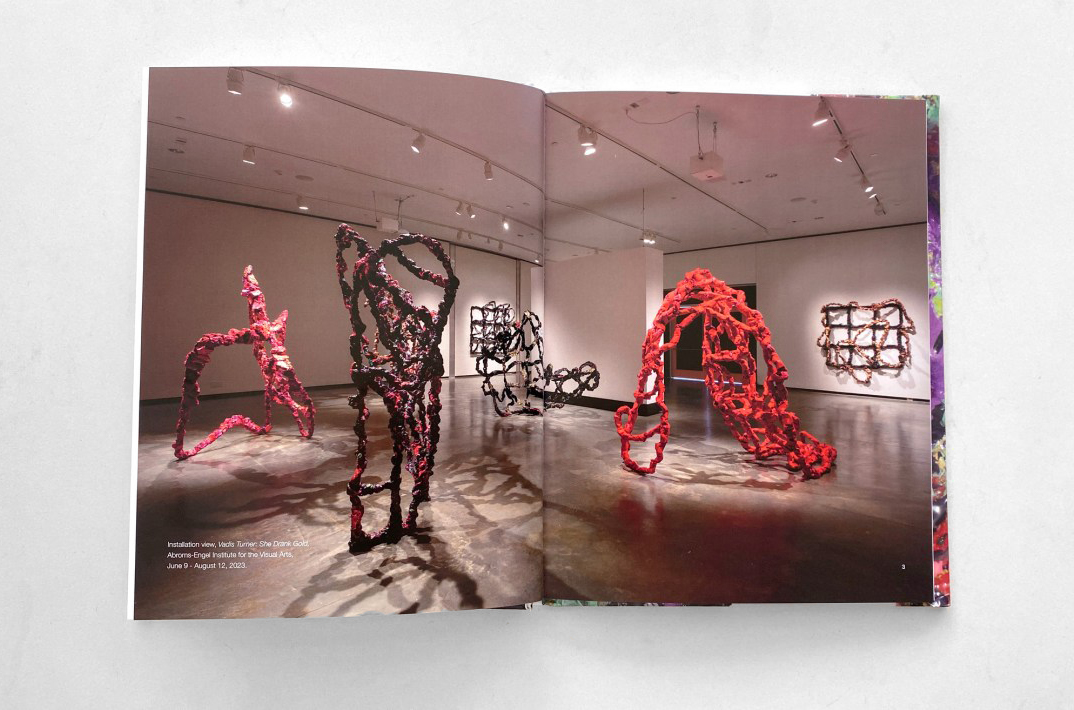Vadis Turner:
She Drank Gold
This 44 page, hardcover catalog features essays by Donald Kuspit, Ciona Rouse, Marilyn Burnett, and includes all artworks featured in the Abroms-Engel Institute for the Visual Arts 2023 exhibition Vadis Turner: She Drank Gold.
Published on the occasion of the exhibition:
Vadis Turner: She Drank Gold
June 9 – August 12, 2023
Abroms-Engel Institute for the Visual Arts
The University of Alabama at Birmingham
Publisher : Abroms-Engel Institute for the Visual Arts
Size: 9.25 x 7.5 Inches
Pages: 44
Binding: Hardback
From the Publication
VADIS TURNER
by Donald KuspitVadis Turner, an innovative female artist, a true originale, known for painting with ribbon and fabric, among other materials associated with women, holds her own with such innovative female weavers as Anni Albers, Gunta Stolzl, Marli Ehrman, all Bauhaus masters. They gave credibility to weaving as high art – modernist art. Their works are pure abstractions, unequivocally geometric, lack social import, and are genderneutral. They stand for nothing but their aesthetic selves. They are triumphs of classical modernism.
In sharp contrast, Turner’s woven grids, however abstract, are paradoxically representational, for each and every one, whether two- or three-dimensional, symbolizes a female figure, a tragic heroine or female outcast, as Turner says, a mythical victim of patriarchal society.
They are a socially critical abstraction, and as such a postmodern abstraction, if postmodernism is a kind of mannerist distortion of High Modernist art the way 16th century mannerism was a distortion of High Renaissance classicism, suggesting its expressive – emotional – shortcomings. One only has to compare Parmigianino’s mannerist Madonna with the Long Neck, 1535-1540, and Raphael’s classical Madonna of the Meadow, 1506, to get the critical point. Mannerist distortion is the ancestor of Surrealist fantasy, and Turner’s female grids – the distortion bespeaks their tragedy – are surrealist fantasies with an expressionistic twist. Weaving has been women’s work since time immemorial.
“Turner’s female grids – the distortion bespeaks their tragedy – are surrealist fantasies with an expressionistic twist.”
The fates being women weavers, women are destined to be weavers. It is feminine to weave, but the grid webs weaves are not wistfully feminine but aggressively feminist, if feminism is concerned to put an end to the exploitation and oppression of women – the dominance of women by men. Are they webs to catch a male eye – fly, considering the fact that Arachne, a weaver who bested Minerva in the art of weaving, was turned into a spider by her?
Danae, one of Turner’s tragic heroines, was raped by Zeus, who came to her in the form of gold, implying she was a prostitute. Titian painted her showered by spermatic gold. Cassandra was a prophet who was never believed; after all, why should a man believe anything a woman says, considering that women are fickle – and insane, as Evelyn De Morgan suggested when he painted Cassandra pulling her hair out. Pandora released all the evils of humanity into the world. John William Waterhouse depicts her as a half-naked seductress opening the box that contains the evils. Circe was a seductress who turned men into swine. Waterhouse shows her half-naked offering wine to Odysseus. Scylla, originally a beautiful woman, was turned into a monstrous sea goddess because she rejected her male suitors. Rosa Salvator painted her beautiful body in the process of changing into an ugly monster. Hagar and her child, Ishmael, were banished into the desert by the patriarch Abraham.
I allude to these paintings to show that the tragic woman was a traditional theme, and to emphasize the imaginativeness and insightfulness of Turner’s abstract rendering of her in contrast to the traditional Neo-Classical representation. They tend to emphasize her seductive body rather than her deranged mind, symbolized by Turner’s tragically black grid. Non-objective art conveys unconscious feeling directly and instantly, as Kandinsky said; Turner’s non-objective art conveys the self-destructive depth of female despair in a patriarchal society.
It may seem strange to say so, but the conceptual brilliance of Turner’s art has as much to do with her recasting of mythological females as inherently complex human beings as with her treatment of them as victims of patriarchy – losers in the war between the sexes. The complexity of Turner’s grids – some have an oblique resemblance to Gordian knots – bespeaks the so-called “mystery of woman.” The intricate gestural strands of Charon, Conduit, and Pandora are ingenious examples.
Were extraordinary women ostracized and persecuted because they were incomprehensible to ordinary men? The name of every last one of Turner’s women was blackened – hence the blackness of her material medium, black the color of death – by men because of their unconscious fear of women, epidemic according to the psychoanalyst Wolfgang Lederer. It is at bottom a fear of her natural superiority, as the anthropologist Ashley Montague argues. Turner’s tragic women may be blackened by male fear expressed as hatred, but inwardly they are pure gold, as the gold grid that accompanies them suggests.


